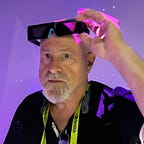VR, AR, MR Defined, Finally
The Consumer Technology Assn seeks to clarify confusing terminology.
As I wrote in an earlier article, lots of companies define their content, including 360 videos, as “virtual reality”. The press has been all to eager to lap up the phrase when anyone utters it, adding to the confusion. Into this gap has stepped the Consumer Technology Association (CTA), a division of the company that produces CES (Consumer Electronics Show), the largest trade show in the world, with 160,000 (not a typo) attendees every January in Las Vegas.
Not a moment too soon, last week CTA’s AR/VR Working Group finalized a set of industry definitions to help companies better explain to consumers the spectrum of experiences their technologies deliver:
- “Virtual Reality” (VR) creates a digital environment that replaces the user’s real-world environment
- “Augmented Reality” (AR) overlays digitally-created content into the user’s real-world environment
- “Mixed Reality” (MR) is an experience that seamlessly blends the user’s real-world environment and digitally-created content, where both environments can coexist and interact with each other
- “360° Video” or “360 Video” allows the user to look in every direction around him/her
- “Immersive Experience” is a deeply-engaging, multisensory, digital experience, which can be delivered using VR, AR, 360° video, MR and/or other technologies
“AR, VR and MR offer consumers a remarkable world of interactive and immersive engagement — whether that’s incorporating information and imagery into our everyday environment or submerging ourselves completely into another world,” said Mark Turner of Technicolor, Chairman of CTA’s AR/VR Working Group.
In addition to Technicolor, the CTA AR/VR Working Group includes member companies Amazon, AMD, Dolby Laboratories, the Fox Innovation Lab at Twentieth Century Fox, GoPro, HTC Vive, Intel, Meta, Microsoft, NVIDIA, Samsung, Sony, STRIVR, Technicolor, and Translink Capital.
CTA’s pending U.S. Consumer Technology Sales and Forecasts industry report, to be released Jan. 3 at CES 2017, shows AR/VR technologies will be among the tech sector’s overwhelming leaders in year-to-year growth in 2016, which was driven by two important developments (1) cheap, untethered mobile headsets and (2) new high-end consumer products like the HTC Vive, Oculus Rift and PlaystationVR. VR unit sales in the U.S. will skyrocket 593 percent over 2015 to 1.4 million units, and total revenues will leap 362 percent to reach $462 million. That’s nothing. Industry analysts are predicting VR hardware sales will climb to 20BN (yes, billion) in 2020 (that’s three years from now) as HMDs become mainstream. Many predict AR headsets, like Microsoft’s HoloLens, will eventually replace computer monitors.
Meanwhile, I’m thankful to the CTA and hope that in 2017 we won’t have to listen to opportunistic producers promote anything viewed with a headset as “virtual reality”.
